Related Research Articles

The Kingdom of Travancore, also known as the Kingdom of Thiruvithamkoor or later as Travancore State, was kingdom that lasted from c. 1729 until 1949. It was ruled by the Travancore Royal Family from Padmanabhapuram, and later Thiruvananthapuram. At its zenith, the kingdom covered most of the south of modern-day Kerala and the southernmost part of modern-day Tamil Nadu with the Thachudaya Kaimal's enclave of Irinjalakuda Koodalmanikyam temple in the neighbouring Kingdom of Cochin. However Tangasseri area of Kollam city and Anchuthengu near Attingal in Thiruvananthapuram were parts of British India.
Nadar is a Tamil caste of India. Nadars are predominant in the districts of Kanyakumari, Thoothukudi, Tirunelveli and Virudhunagar.

Travancore–Cochin, officially the United State of Travancore and Cochin and later the State of Travancore–Cochin, was a short-lived state of India. It was formed through the merger of two former kingdoms, Travancore and Cochin on 1 July 1949. Its original capital was Thiruvananthapuram.

The Madras Presidency or Madras Province, officially called the Presidency of Fort St. George until 1937, was an administrative subdivision (province) of British India and later the Dominion of India. At its greatest extent, the presidency included most of southern India, including all of present-day Andhra Pradesh, almost all of Tamil Nadu and parts of Kerala, Karnataka, Odisha and Telangana in the modern day. The city of Madras was the winter capital of the presidency and Ooty was the summer capital.
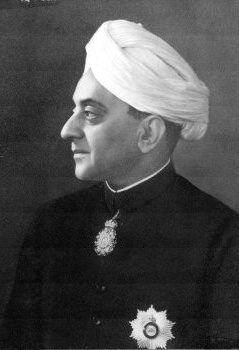
Dewan Bahadur Sachivottama SirChetput Pattabhiraman Ramaswami Iyer, popularly known as Sir C. P., was an Indian lawyer, administrator and statesman, acknowledged as the most powerful man in the Madras Presidency in the decades immediately prior to Indian Independence.
Agastheeswaram is a panchayat town in Kanniyakumari district in the Indian state of Tamil Nadu.
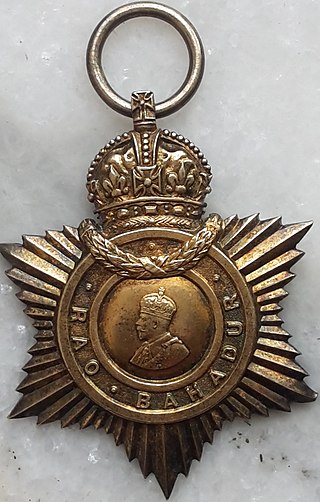
Rao Bahadur and Rai Bahadur, abbreviatedR.B., was a title of honour bestowed during British rule in India to individuals for outstanding service or acts of public welfare to the Empire. From 1911, the title was accompanied by a medal called a Title Badge. Translated, Rao means "King", and Bahadur means "Brave". Bestowed mainly on Hindus, the equivalent title for Muslim and Parsi subjects was Khan Bahadur. For Sikhs it was Sardar Bahadur.

Velayudhan Chempakaraman Thampi ofThalakulam (1765–1809) was the Dalawa or Prime Minister of the Indian kingdom of Travancore between 1802 and 1809 during the reign of Bala Rama Varma Kulasekhara Perumal. He is best known for being one of the earliest individuals to rebel against the British East India Company's authority in India.
Sathyan was an Indian actor known for his work in Malayalam cinema. Known for his own style and versatility in acting, Satyan was one of the pioneers of realistic acting in Indian film industry. He is respectfully called Sathyan Master. He was also a soldier in the British Indian Army and later a police officer with the Travancore State Police.

Sri Padmanabha DasaSir Sri Visakham Thirunal Rama Varma VFRAS, also known as Rama Varma the Learned, was the Maharaja of Travancore from 1880 to 1885 AD, succeeding his elder brother Ayilyam Thirunal on the musnud, or throne. He was a noted scholar of Sanskrit and literary composer in Malayalam, who reversed his brother's policy, liberally patronizing poet Kerala Varma, while hostile to painter Raja Ravi Varma.
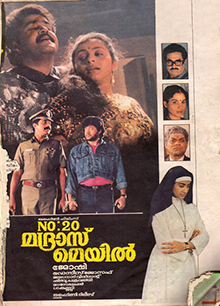
No. 20 Madras Mail is a 1990 Indian Malayalam-language comedy thriller film directed by Joshiy and written by Dennis Joseph from a story by Harikumar. The film stars Mohanlal in lead role and Jagadish, Maniyanpilla Raju, M. G. Soman, Ashokan, and Suchitra Murali in supporting roles, while Mammootty appears in an extended cameo as himself. The background score was composed by S. P. Venkatesh while the song was composed by Ouseppachan. The plot follows three youngsters who are embroiled in the murder mystery of a young woman in a train journey from Thiruvananthapuram to Madras. No.20 Madras Mail was released on 16 February 1990 and received positive reviews. Almost half of the film was shot inside a train. Four years later, the film was remade in Hindi as Teesra Kaun by Partho Ghosh.
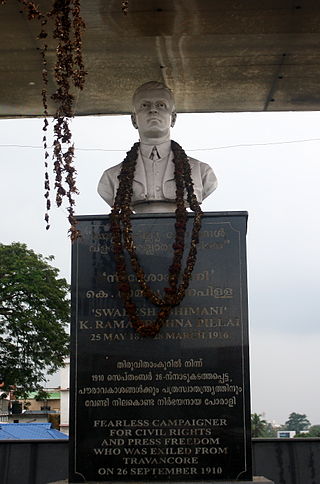
K. Ramakrishna Pillai (1878–1916) was an Indian nationalist writer, journalist, editor, and political activist. He edited Swadeshabhimani, the newspaper which became a potent weapon against the rule of the British and the erstwhile princely state of Travancore and a tool for social transformation. His criticism of the Diwan of Travancore, P. Rajagopalachari and the Maharajah led to the eventual confiscation of the newspaper. Ramakrishna Pillai was arrested and exiled from Travancore in 1910. Vrithantha Pathra Pravarthanam (1912) and Karl Marx (1912) are among his most noted works in Malayalam, Vrithantha Pathra pravarthanam being the first book on journalism in Malayalam and Karl Marx, the first ever biography of Karl Marx in any Indian language. But it has been alleged that he plagiarized the biography from an essay, "Karl Marx: A Modern Rishi", by Lala Hardayal, published in 1912 March issue of the Modern Review, published from Kolkata.
Kayamkulam Kochunni was a heroic outlaw from Kayamkulam, who lived during the late 19th century. He was active in the Travancore area in the present-day Kerala, India. He is said to have stolen from the rich and given to the poor. Legends on his life are part of the folklore of Kerala. His stories are often associated with his friend and fellow outlaw Ithikkara Pakki. A shrine dedicated to Kochunni exist near Kozhencherry.
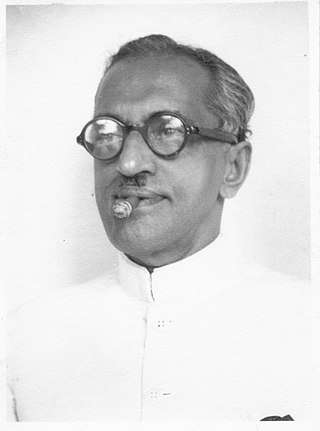
Chalakuzhy Paulose Mathen was an Indian politician who served as a member of the Indian Parliament in the first Lok Sabha, constituted in 1952 after India gained independence from the United Kingdom. He represented the Thiruvalla constituency of Kerala. Mathen was appointed the Indian Ambassador to Sudan after his single term in the Lok Sabha.
The Travancore rebellion against the British East India Company was led by the prime ministers of the Indian states of Travancore and Cochin in 1808–09 with support from Sikhs ruling Punjab.
Vinu Chakravarthy was an Indian actor, screenwriter and director who is known for acting in more than 1000 movies predominately in Tamil films mostly as a comedian, supporting actor or in a villainous role. The 2007 released Tamil movie Muni was his landmark 1000th movie.
The present-day Kanyakumari district and parts of Tenkasi district of Tamil Nadu state in India was originally a part of the Travancore-Cochin state. Between 1945 and 1956, especially after the Government of India announced plans to reorganize states along linguistic lines, the people of Tamil-majority Kanyakumari campaigned for its inclusion in the Madras State instead of the Malayalam-majority Kerala state. In Tamil, the campaign is also known as Therkku Ellai Porattam.
Ithikkara Pakki was an Indian outlaw who lived in the Travancore Kingdom in the 19th century. He is said to have plundered from the rich and distributed to the poor. Pakki, whose real name was Muhammad Abdul Khader, hails from Ithikkara village. He is said to have moved as swiftly as a bird or butterfly, meaning Pakki in Malayalam, hence he was known by the name Ithikkara Pakki.
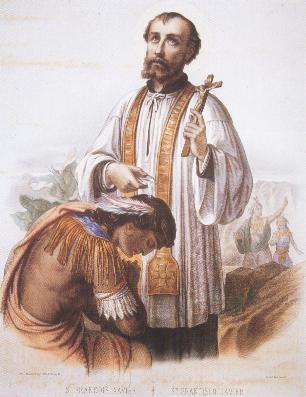
The Latin Catholics of Malabar Coast, also known as Malabar Latin Catholics or Latin Christians of Kerala are a multi-ethnic religious group in Kerala adhering to the Roman Rite liturgical practices of the Latin Church, on the Malabar Coast, the southwestern coast of India. Ecclesiastically, they constitute the ecclesiastical provinces of Verapoly and Trivandrum. They are predominantly Malayali people and speak the Malayalam language, though a subgroup of Luso-Indians speaks the Cochin Portuguese Creole. They trace their origins to the evangelization of Malabar Coast by the Dominican, Franciscan, Jesuit and Carmelite missionaries, mainly French and Portuguese.

S Suresh Babu is an Indian film screenwriter and artist who predominantly works in Malayalam cinema. He made his debut as a writer in the movie Dada Sahib in the year 2000, with Director Vinayan and actor Mammootty. Since then, he has worked on movies like Shikkar (2010), Thiruvambadi Thamban (2012), Nadan (2013), Jalam (2016) and Oruthee (2022). The movie Oruthee acted by Navya Nair marked her return to Malayalam cinema after 10 years and it was a commercial success.
References
- ↑ "Crimes that rocked Madras". The Times of India.